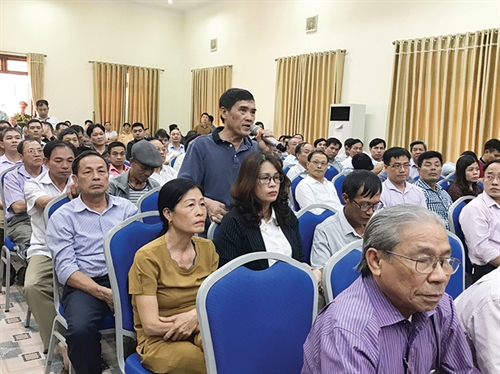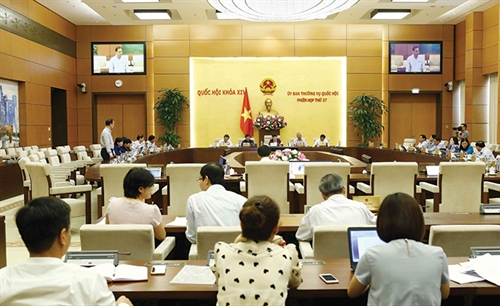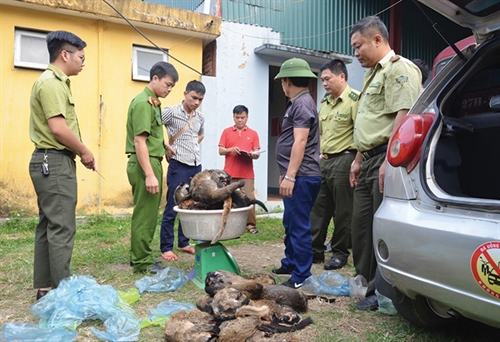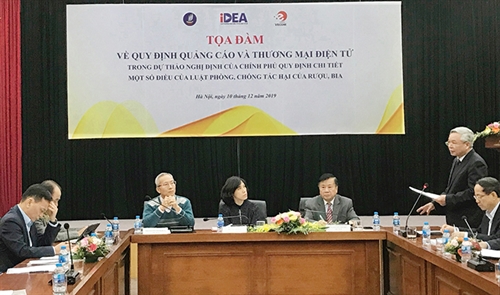Vietnam is one of the most biodiverse countries in the world. However, the increase in human population and illegal wildlife hunting has led to a high risk of biodiversity loss and put many of the animals on the brink of extinction. Being fully aware of the seriousness of the situation, the Vietnamese Government has focused on improving the legal framework on wildlife conservation and protection. This article briefly introduces legal documents related to wildlife conservation and protection, analyzes shortcomings and limitations and puts forth some recommendations for improvement.
Vu Thuy Hoa, M.A.
Deputy Editor-in-Chief of the Supreme People’s Court Magazine
In order to conserve and protect wildlife, it is needed to fulfill two closely interrelated tasks: conserving the ecosystem in which wildlife live and protecting them from invasion of various objective and subjective factors. Reality shows that wildlife species are facing numerous threats such as climate change, environmental pollution, disease, hunting and over-exploitation of which illegal hunting, trading and consumption can be cited as the main reasons behind the rapid reduction in the number of wildlife. Dr. Van Ngoc Thinh, Country Director of the World Wildlife Fund (WWF), issued a warning when assessing the vulnerability of natural ecosystems over the years[1]: “We are at the sixth mass extinction since the dinosaurs disappeared and this is the first human-made extinction. Our planet is collapsing.”
The conservation and protection of wildlife and endangered, precious and rare animals have become a matter of urgency for all countries in the world and Vietnam is not an exception. The country is witnessing an increasing risk of extinction of not a few fauna and flora species. According to the Vietnam Red Data Book 2007, 882 species, including 418 fauna species and 464 flora species, in the country are threatened, an increase of 167 species compared to the 1992’s figures. Amongst those, 116 fauna species are classified as “very endangered” and 45 flora species are classified as “critically endangered”. Nine animal species earlier classified as “threatened” are considered extinct at the moment, including two-horn rhino, kouprey, tapir, otter civet, cyprinid fish, Japanese eel, multi carp, saltwater crocodile, sika deer and slipper orchids.
 |
| A Vietnam mouse-deer, also known as the silver-backed chevrotain, is detected in Nui Chua national park for the first time in 30 years__Photo: VNA |
To deal with the situation, Vietnam has utilized different political, economic and legal measures. Politically, wildlife conservation and protection have been considered by the Communist Party of Vietnam as a key task which must be fulfilled. The 11th Party Central Committee, at its 7th session in June 2013, pointed out that “Biodiversity is declining and the risk of ecological imbalance is spreading on a large scale, adversely affecting socio-economic development as well as people’s health and life” and set a very specific and central task, i.e., “to strictly protect endangered, precious and rare wildlife at the brink of extinction”. Economically, the country has formed several environmental protection foundations. Legally, a legal system on wildlife conservation and protection has been step by step formulated and improved, creating a legal foundation for dealing with wildlife-related violations.
Vietnam’s legal system on wildlife conservation and protection
It is undeniable that legal measures constitute the most practical and effective way to conserve and protect wildlife and endangered, precious and rare species. Being fully aware of the role and significance of law in conservation and protection of wildlife and endangered, rare and specious species, the Vietnamese State has paid special attention to the formulation of a legal system on environmental protection and biodiversity conservation, including wildlife protection law.
From the first documents issued in the early days after the founding of the Democratic Republic of Vietnam, e.g., Decree 131 dated July 20, 1946, and Decree 142 dated December 21, 1949, specifying the functions and tasks of forest rangers, the main force in charge of forest protection and development, Vietnam’s legal system on conservation and protection of wildlife and endangered, precious and rare species has been remarkably improved, especially after the country joined the Convention on International Trade in Endangered Species of Wild Fauna and Flora (CITES) and the Convention on Biological Diversity (CBD) in 1994, and now consists of numerous documents of different levels in different fields, ranging from codes and laws of the National Assembly to sub-law documents issued by the Government, Supreme People’s Court, Prime Minister, and ministries and functional agencies. Important documents include the 2008 Law on Biodiversity, 2017 Law on Forestry, 2014 Investment Law, 2012 Law on Handling of Administrative Violations, 2015 Penal Code, 2015 Criminal Procedure Code, and 2015 Law on Organization of Criminal Investigation Agencies; Government Decree 06 of 2019 on management of endangered, precious and rare forest plants and animals and the implementation of the CITES; Resolution 05 of 2018 of the Judicial Council of the Supreme People’s Court guiding the application of the Penal Code’s Articles 234 and 244 on violations of regulations on protection of wildlife and endangered, precious and rare wild animals; Prime Minister Decision 1250 of 2013 adopting the national strategy on biodiversity up to 2020, with a vision toward 2030, and Decision 45 of 2014 approving the overall master plan on biodiversity conservation up to 2020, with orientations toward 2030; and Ministry of Agriculture and Rural Development Circular 27 of 2018 providing the management and tracing of origin of forest products.
Effectiveness of regulations on wildlife conservation and protection
Although there is no official division of the legal system on wildlife conservation and protection into two branches: law on wildlife conservation and law on wildlife protection, such a division is sometimes applied by legal experts for convenience in research activities. Similarly, legal relations on protection of wildlife and endangered, precious and rare animals can be divided into three basic groups: (i) regulations on management and protection of wildlife and endangered, precious and rare animals; (ii) regulations on handling of violations of laws on protection of wildlife and endangered, precious and rare animals; and (iii) regulations on handling of material evidence and rescue of wildlife and endangered, precious and rare animals. However, the division in the two cases mentioned above are quite comparative and mostly serve research purposes only.
This article focuses on assessing the most important and basic legal provisions on the protection of wildlife and endangered, precious and rare animals - that is the handling of violations related to wildlife, and endangered, precious and rare animals, from administrative sanctioning to criminal liability examination, as well as the handling of confiscated wildlife.
Law on conservation of wildlife
According to the Vietnamese dictionary, “conservation” means to preserve (the historical meaning belonging to common property) from damage and loss. Hence, conservation of wildlife and endangered, precious and rare wild animals is a legal activity carried out by competent state agencies. After referring to many different sources, the author agrees with Phan Vinh Tuan Anh’s opinion that: “The law on conservation of endangered, precious and rare animals is a system of legal norms and rules governing social relations arising in the process of exploitation, use, trading, and transportation of, or impacting, endangered, precious and rare animals in order to effectively conserve endangered, precious and rare species at risk of extinction, which are promulgated or recognized by the State and have their enforcement ensured by coercive powers”[2]. Generally, law can be seen as an effective tool that helps facilitate and ensure the effectiveness of conservation activities through assigning specific responsibilities to related stakeholders and thereby serving as a solid legal basis for identifying responsibilities of each specific subject when a violation occurs; changes behaviors of individuals, organizations and households participating in environmental relations; and especially, creates favorable conditions for inspection, examination and supervision of conservation activities and handling of violations[3].
In Vietnam, the legal system on wildlife conservation has established a uniform conservation mechanism for endangered, precious and rare species in national parks and conservation zones nationwide and at the same time devised effective mechanisms for controlling commercial farming and transportation of endangered, precious and rare native animals out of their places of origin, thus facilitating the control and supervision of the import and export of endangered, precious and rare animals by state agencies, based on specific and clear legal mechanisms[4].
However, there remain limitations. Despite the great number of legal documents on wildlife conservation, Vietnam still lacks a specific law governing this issue. The fact that regulations on wildlife conservation are not included in a single document but scattered in different documents leads to many difficulties in implementation.
For instance, there exist three lists of endangered, precious and rare fauna and flora species promulgated under three different legal documents relating to wildlife management and protection, including: (i) the list of endangered, precious and rare forest plants and animals with 92 species of group IB, and 97 species of group IIB, issued together with Decree 06 of 2019; (ii) the list of 83 endangered, precious and rare fauna species prioritized for protection, promulgated under Decree 160 of 2013; and (iii) the list of 90 endangered, precious and rare species banned from exploitation and use for investment and business purposes, provided in an appendix to the 2014 Investment Law”[5]. Of these three lists, the last two ones basically coincide with the first one, the list of endangered, precious and rare animals issued under Decree 06 of 2019.
In order to better meet practical requirements, in July 2019, the Government issued Decree 64 amending Decree 160 of 2013 which stipulates that the list of endangered, precious and rare species prioritized for protection will be revised once every three years or when necessary. Hence, what will happen when a species not yet included in the list of endangered, precious and rare forest plants and animals issued together with Decree 09 of 2019 is added to the list of endangered, precious and rare species prioritized for protection? It is not to mention the overlaps in state management work which might cause difficulties for authorities in management and handling of wildlife-related violations.
Law on protection of wildlife
Protection of wildlife involves activities which aim at helping animals live and develop according to law of nature and protecting them from such dangers as illegal trafficking, hunting and capture. Wildlife protection also has a very important significance, i.e., creating an environment for the growth and development of wildlife so as to help them escape from extinction. “Protection of endangered, precious and rare forest animals is an activity in a series of activities to conserve wildlife and biodiversity which is conducted with the coordination of different entities by different tools and methods in different forms.”[6]
Among various methods to protect wildlife, the exertion of impacts on human behavior appears the most effective. A system of regulations regulating human behavior the enforcement of which is guaranteed by the state power will be highly effective for wildlife protection. Meanwhile, strict sanctions will deter and prevent the commission of violations in this field.
It can be said that Vietnam’s legal system on protection of wildlife and endangered, precious and rare animals is rather comprehensive, complete, and strict and can be divided into different groups of regulations such as regulations on wildlife management; regulations on handling of wildlife-related violations; and regulations on handling of confiscated material evidence being wild animals.
Regarding regulations on handling of wildlife-related violations, the crime of violating regulations on forest management and protection had been provided in the 1985 Penal Code, the first Penal Code of Vietnam. In the 1999 Penal Code, the offense of violating regulations on protection of animals on the list of endangered, precious and rare species prioritized for protection is stipulated in a separate article (Article 190). In 2015 when designing a new code to replace the 1999 Code, legislators devote two articles to regulate crimes related to wildlife and endangered, precious and rare animals (Articles 234 and 244 of the 2015 Code, revised in 2017). Compared to the previous versions, the 2015 Code stipulates violating acts in a more specific manner and imposes more severe penalties on violators. For example, while the 1999 Code provides a maximum imprisonment sentence of seven years for violators, under the 2005 Code, those who violate regulations on wildlife management and protection will be sentenced to imprisonment of up to 12 years while the maximum penalty for violating regulations on protection of endangered, precious and rare animals is 15 years in jail. This is a clear evidence showing the determination of the Vietnamese Government to ensure effective implementation of the CITES.
Additionally, the 2017 Law on Forestry and 2015 Criminal Procedure Code also define the functions, tasks and powers of the Forest Ranger force, aiming to ensure the maximum effectiveness of forest protection in general and wildlife protection in particular. Article 103 of the 2017 Law on Forestry stipulates: “The Forest Ranger is an organization with the function of managing and protecting forests and ensuring the enforcement of the law on forestry; and is a specialized force in charge of forest fire prevention and fighting”. In the 2015 Criminal Procedure Code, the tasks and powers of the Forest Ranger force are stipulated in two articles (Articles 39 and 106). Particularly, Article 106.3.d provides the handling of material evidence being wild animals and exotic plants as follows: “Right after obtaining expert conclusions, exhibits being wild animals and exotic plants must be handed over to competent specialized management agencies for handling in accordance with law”. Meanwhile, the Forest Ranger force’s tasks to conduct a number of criminal investigation activities are defined in the 2015 Law on Organization of Criminal Investigation Agencies (Articles 9 and 34).
In addition to provisions on handling of violations as mentioned above, the law on protection of wildlife and endangered, precious and rare animals also includes provisions on handling of material evidence being wild animals or endangered, precious and rare animals. However, these provisions have revealed many limitations and shortcomings, especially those relating to the competence to sanction violations with material evidence being wild animals. At present, the Forest Ranger force’s competence to sanction wildlife-related violations is provided in different legal documents. Specifically, Decree 35 of 2019 specifies the force’s competence to sanction violations with material evidence being forest animals; Decree 155 of 2016 stipulates the sanctioning of acts of illegally exploiting wild species not on the list of endangered, precious and rare species prioritized for protection in strictly protected areas of conservation zones (Article 41). However, there is currently no regulation on the Forest Ranger force’s power to sanction the acts of illegally hunting, transporting, trading in, and storing wildlife species outside strictly protected areas of conservation zones, making the force incapable of handling violations involving special species, e.g., migratory birds.
Another problem lies in regulations on management and handling of assets being forest animals. Under Decree 160 of 2013, confiscated wildlife may be handled by: (i) release into the natural environment; (ii) rescue and return to the natural environment; (iii) sale to lawfully operating zoos or destruction; or (iv) humane destruction. Meanwhile, Ministry of Agriculture and Rural Development Circular 90 of 2008 permits the sale of confiscated wild animals to artistic groups or business entities. Fortunately, in January 2019, the Government issued Decree 06 which has, to some extent, resolved inconsistencies in legal provisions on the handling of confiscated wildlife. Article 10 of Decree 06 stipulates the handling of confiscated wildlife specimens as follows:
“1. Handling of live specimens:
a/ The handling and confiscation of live specimens must be carried out in a manner that ensures the provision of care to, and avoids the risk of death of these specimens;
b/ Immediately after specimens are handled in accordance with law, they must be handed over to local forest protection agencies for care and preservation. Live specimens shall be handled by the following methods in the following order of priority: release into the natural environment suitable to the habitat and natural distribution of the species, if the specimens are healthy; or transfer to animal rescue centers or zoological or botanical gardens, if the specimens are weak and need rescue or destruction.
2. Specimens of endangered, precious and rare forest plants and animals other than those specified in Clause 1 of this Article shall be handled as follows:
a/ Specimens of species of groups IA and IB shall be handled in compliance with the law on management and use of public assets;
b/ Specimens of species of groups IIA and IIB shall be transferred to science organizations, training institutions, environmental education institutions or specialized museums for display for conservation education purposes; sale by auction to organizations and individuals engaged in rearing, cultivation, processing or business in accordance with law; or destruction in case when other handling measures cannot be taken”.
Especially, in December 2019, the Ministry of Agriculture and Rural Development issued Circular 29 on handling of material evidence being forest animals and forest animals voluntarily handed over to the State by organizations and individuals, with provisions on care for, preservation, receipt and handling of forest animals. However, some of these regulations are quite general and difficult to apply. For instance, Article 4.2 states: “In case the agency temporarily seizing forest animals cannot afford to care for and preserve them, they shall transfer forest animals to the facilities having conditions for taking care and preserving wildlife pending the handling decisions of competent persons”.
Because of the lack of specific criteria for identifying which facilities are considered capable to take care and preserve confiscated animals, such provision can hardly be implemented in reality.
In addition, under the current law, confiscated material evidence being endangered, precious and rare animals must be handed over to local Forest Ranger agencies but not to private facilities. Nevertheless, due to funding shortage, state-run facilities are seemingly unable to properly take care of forest animals. Meanwhile, non-state rescue centers and wildlife farms usually have better conditions. In the author’s opinion, regulations on transfer of confiscated wild animals to non-state facilities should be soon added so as to suit realities.
Recommendations
In summary, it can be said that, to some extent, the legal system on conservation and protection of wildlife and endangered, precious and rare animals has contributed significantly to the protection and management of wildlife, and prevention of violations against wildlife. However, there remain a lot of problems that need to be solved in the coming time.
In the short term, it is necessary to study and improve the legal framework on management of wildlife and endangered, precious and rare species. It would be better if we could elaborate a single list of wildlife and endangered, precious and rare species which are managed and protected under a common regime, thus facilitating management as well as handling of violations by functional agencies.
Another job that needs to be shortly performed is to revise and improve legal documents on handling of material evidence being wildlife and endangered, precious and rare animals. Perhaps, a joint circular governing this issue should be issued to assign an agency to act as the focal point in managing, monitoring, supervising, and setting up a database on, material evidence being wildlife and endangered, precious and rare animals. Such a circular should also specify the order, procedures and measures for handling these material evidence, funds for rescue activities, and other matters. Besides, authorities should devise mechanisms for mobilization of social resources of rescue and conservation activities for confiscated wildlife and endangered, precious and rare animals.
In the long run, it is required to study the development of a law regulating the conservation and protection of wildlife and endangered, precious and rare species so as to ensure comprehensive management and avoid inconsistencies in wildlife conservation and protection activities.-









